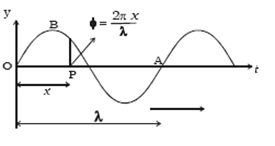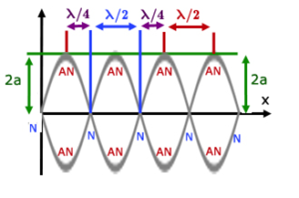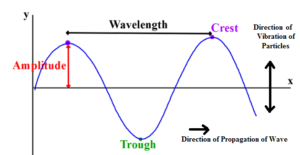Science > Physics > Wave Motion > Wave Motion
In the last article, we have studied the concept of wave motion, its terminology and its characteristics. In this article, we shall study different types of waves and their characteristics.
Wave in a medium may be defined as the disturbance moving through the medium without change of form. e.g. ripple in water formed due to dropping a stone in water. Wave motion is a mode of transfer of energy or a form of disturbance travelling through an elastic medium due to the repeated oscillations of the particles of the medium about their mean positions.
Classification of Mechanical Waves:
Classification Based on the Motion of Wave in a Space:
Depending on the motion of wave in a space the waves are classified into three types
- One-dimensional waves: The wave which moves in a straight line is called a one-dimensional wave. e.g. transverse wave set in a rope.
- Two-dimensional waves: The wave which moves in a plane is called a two-dimensional wave. e.g. ripple in the water.
- Three-dimensional waves: The wave which moves in a space is called a three-dimensional wave. e.g. Radio wave from transmitting tower.
Classification Based on Requirement of Medium:
Depending upon requirement of medium, waves are classified as mechanical waves, electromagnetic waves and matter waves.
Mechanical Waves:
A mechanical wave is a disturbance in matter that transfers energy through the matter. Mechanical waves are not capable of transmitting its energy through a vacuum.
Examples: Sound waves, seismic waves, wave produced in rope, surface waves etc.
Characteristics of Mechanical Waves:
- They are produced when there is a disturbance in the medium.
- For their propagation material medium is required. They cannot travel though vacuum.
- The propagation of mechanical waves depends on the elastic properties of the medium through which the waves pass.
- They can travel short distances compared to electromagnetic waves.
- Mechanical waves travel through medium with lower speed compared to that of electromagnetic waves.
- They can move as longitudinal or transverse waves.
Electromagnetic Waves:
Electromagnetic waves are produced once electrically charged particles accelerate and interact with other particles.
Examples: Light waves, radiant energy, etc.
Characteristics of Electromagnetic Waves:
- They are produced when charged particles move through medium with acceleration.
- For their propagation material medium is not required. They can travel though vacuum.
- They are caused due to the varying magnetic and electric fields.
- They travel through medium with very high speed comparable with that of light (3 x 108 m s-1).
- They can travel very long distances.
- They move in form of transverse waves.
Distinguish Between Mechanical waves and Electromagnetic Waves:
| Mechanical Waves | Electromagnetic Waves |
| A mechanical wave is a disturbance in matter that transfers energy through the matter. | Electromagnetic waves are produced once electrically charged particles accelerate and interact with other particles. |
| Mechanical waves require a medium to travel. | Electromagnetic waves can travel through any medium and even through a vacuum. |
| The propagation of mechanical waves depends on the elastic properties of the medium through which the waves pass. | Electromagnetic waves are caused due to the varying magnetic and electric fields. |
| mechanical waves are caused by wave amplitude and not by frequency | Electromagnetic waves are produced by the vibration of the charged particles. |
| Mechanical waves travel through medium with lower speed. | Electromagnetic waves travel through medium with high speed. |
| They can travel short distances compared to electromagnetic waves. | They can travel very long distances. |
| They can move as longitudinal or transverse waves. | They move in form of transverse waves. |
| Examples: Sound waves, seismic waves, wave produced in rope, surface waves etc. | Examples: Light waves, radiant energy, micro waves, radio waves, etc. |
Matter Waves:
According to De-Broglie, a wave is associated with each moving particle which is called matter waves. This wave has wave length λ=hp. Here h is Planck’s constant and p is the moment of the moving particle. Electron microscope works on the basis of de-Broglie waves.
Characteristics of Matter waves:
- De-Broglie or matter wave is independent of the charge on the material particle. It means, matter wave of de-Broglie wave is associated with every moving particle (whether charged or uncharged).
- Matter wave represents the probability of finding a particle in space.
- Matter waves can propagate in a vacuum, hence they are not mechanical waves.
- De-Broglie wave length is inversely proportional to the mass of the particle. Lighter the particle, greater is the De-Broglie wave length and the faster the particle moves, the smaller is its De-Broglie wave length.
- The De-Broglie wave length of a particle in independent of the charge or nature of the particle.
The matter waves are not electromagnetic in nature. The electromagnetic waves are produced only by charged particle. - The phase velocity of matter waves can be greater than the speed of light.
- Only those circular orbits around the nucleus are stable whose circumference is integral multiple of de-Broglie wavelength associated with the orbital electron.
- The number of de-Broglie waves associated with the nth orbital electron is n
Classification Based on the Limitations of Motion:
Depending upon the limitations of motion, waves are classified as progressive waves and stationary waves.
Progressive Wave:
The wave advancing in the given direction continuously is called a progressive wave e.g. sound waves. In an unbounded (infinite)) medium, the progressive wave travels in a given direction continuously until it gets dissipated.

Characteristics of Progressive Waves:
- They are produced when a disturbance is created in an elastic medium.
- They continuously travel away from the source.
- They transfer energy through the medium.
- All the particles of the medium perform SHM with the same amplitude.
- Every particle of the medium is set into vibrations.
- Different particles have got different phases at a given instant.
- Equation of the wave is
y = a sinn2π(t/T – x/ λ )
Stationary Waves:
When two, identical, progressive waves of equal amplitudes and equal wavelengths and traveling in the same medium, along the same straight line, but in opposite directions, interfere, then the wave formed is called a standing wave or a stationary wave.

Characteristics of Stationary Waves:
- They are produced due to the interference of two identical progressive waves traveling along the same path but in opposite directions.
- They move neither forward nor backward.
- In a stationary wave, the energy is not transported from one point to another.
- The particles of the medium perform S. H. M. of the same period but the amplitude of the oscillations varies periodically in space.
- There are some particles of the medium which do not at all vibrate i.e. their amplitude is zero. These are called nodes. Some particles vibrate with maximum amplitude and are called antinodes.
- All the particles in the same loop have the same phase at a given instant.
- Equation of the wave is

- The distance between two successive antinodes, or two successive nodes is constant and equal to l/2.
- The distance between a node and the adjacent antinodes is λ/4.
- There is no progressive change of phase from particle to particle. In fact, all the particles in any one segment or loop vibrate in the same phase, while particles in any two adjacent segments are in the opposite phase.
- Stationary waves can be produced by the interference of either longitudinal or transverse waves.
|
Progressive Waves |
Stationary waves |
|
The wave advancing in the given direction continuously is called a progressive wave |
When two, identical, progressive waves of equal amplitudes and equal wavelengths and traveling in the same medium, along the same straight line, but in opposite directions, interfere, then the wave formed is called a standing wave or a stationary wave. |
|
They continuously travel away from the source. |
They move neither forward nor backward. |
|
They transfer energy through the medium. |
Energy is not transported from one point to another. |
|
All the particles of the medium perform SHM with the same amplitude. |
The particles of the medium perform S. H. M. of the same period but the amplitude of the oscillations varies periodically in space. |
|
Every particle of the medium is set into vibrations. |
There are some particles of the medium which do not at all vibrate i.e. their amplitude is zero. These are called nodes. Some particles vibrate with maximum amplitude and are called antinodes. |
|
Different particles have got different phases at a given instant. |
All the particles in the same loop have the same phase at a given instant. |
|
Equation of the wave is y = a sinn2π(t/T – x/ λ ) |
Equation of the wave is y = 2a sin(2πt/T) cos (2πx/λ) |
We shall discuss progressive waves and stationary waves in upcoming articles.
Classification Based on the Direction of Vibration of Medium Particles:
Depending upon the direction of the vibration of medium particles w.r.t the direction of the propagation of the wave, mechanical; waves are classified into two types a) transverse waves and b) longitudinal waves.
- Transverse Waves: A progressive wave is a wave in which the medium particles are vibrating in the direction perpendicular to the direction of propagation of the wave is called a transverse wave. e.g. the wave produced in a rope by tying the rope at one end to a rigid wall and jerked at the other end.
- Longitudinal Waves: A progressive wave is a wave in which the medium particles are vibrating in the direction parallel to the direction of propagation of the wave is called a longitudinal wave. e.g. sound wave
Transverse Waves:
A progressive wave is a wave in which the medium particles are vibrating in the direction perpendicular to the direction of propagation of the wave is called a transverse wave. e.g. the wave produced in a rope by tying the rope at one end to a rigid wall and jerked at the other end.

- Crest: The convex part formed by the wave due to upward displacement of the particles of the medium, is called the crest.
- Trough: The convex part formed by the wave due to downward displacement of the particles of the medium, is called the trough.
Characteristics of Transverse Waves:
- When transverse waves pass through a medium, the medium gets divided into alternate crests and troughs.
- A crest and trough form a transverse wave.
- The crests and troughs follow each other in rapid succession i.e. crests and troughs are produced alternatively at the same point of the medium.
- Every particle of medium performs S.H.M. of the same amplitude and period.
- Every particle lags behind the previous particle in a phase.
- The distance between two successive particles in the same phase is constant and it is called wavelength of the wave.
- Consecutive crest and trough constitute one cycle of a transverse wave.
- The transverse waves are produced in a medium, which undergoes a change of shape. Hence transverse waves can be propagated only through solids.
Longitudinal Waves:
A progressive wave is a wave in which the medium particles are vibrating in the direction parallel to the direction of propagation of the wave is called a longitudinal wave. e.g. sound wave

- Compression: The region where the particles of the medium are crowded together is called the compression. Sometimes compression is also referred as the condensation. At compression, the density of the medium is higher. Similarly, the pressure at the compression is more than the normal pressure of the medium.
- Rarefaction: The region where the particles of the medium are widely separated is called the rarefaction. Sometimes rarefaction is also referred as the extension. At rarefaction, the density of the medium is lower. Similarly, the pressure at the rarefaction is less than the normal pressure of the medium.
Characteristics of Longitudinal Waves:
- When longitudinal waves pass through a medium, the medium gets divided into alternate condensations (compressions) and rarefactions (relaxation).
- Compressions and rarefactions form a longitudinal wave.
- The compressions and rarefactions follow each other in rapid succession i.e. compressions and rarefactions are produced alternatively at the same point of the medium.
- Every particle of medium performs S.H.M. of the same amplitude and period.
- Every particle lags behind the previous particle in a phase.
- The distance between two successive particles in the same phase is constant and it is called wavelength of the wave.
- Consecutive compression and rarefaction constitute one cycle of a longitudinal wave.
- The Longitudinal waves are produced in a medium, which undergoes a change in volume and pressure. Hence longitudinal waves can be propagated through solids, liquids, and gases.
| Transverse waves | Longitudinal waves |
| A progressive wave in which the medium particles are vibrating in the direction perpendicular to the direction of propagation of wave is called as transverse wave. | A progressive wave in which the medium particles are vibrating in the direction perpendicular to the direction of propagation of wave is called as transverse wave. |
| When transverse waves pass through a medium, the medium gets divided into alternate crests and troughs. | When Longitudinal waves pass through a medium, the medium gets divided into alternate condensations (compressions) and rarefactions (relaxation). |
| A crest and trough forms transverse wave. | A compression and rarefaction forms Longitudinal wave. |
| The crests and troughs follow each other in rapid succession i.e. crests and troughs are produced alternatively at the same point of the medium. | The compressions and rarefactions follow each other in rapid succession i.e. compressions and rarefactions are produced alternatively at the same point of the medium. |
| Consecutive crest and trough constitute one cycle of transverse wave. | Consecutive compression and rarefaction constitute one cycle of Longitudinal wave. |
| The transverse waves are produced in a medium, which undergoes change of shape. Hence transverse waves can be propagated only through solids. | The Longitudinal waves are produced in a medium, which undergoes change in volume and pressure. Hence Longitudinal waves can be propagated through solids, liquids and gases. |
Sound waves as longitudinal waves:
Sound waves are the longitudinal waves. It can be explained as follows.

Consider vibrating tuning fork. When the prongs of the tuning fork at rest the layers of medium (air) are at normal pressure. Now let us assume that the prongs of the fork are vibrating and the prongs are parting away. During this process the prong will push the layers of air one over other and the air in this region gets compressed. Thus in this region pressure is maximum. This region is called compression. When the prongs return back to their normal position the pressure also becomes normal.
Now, when the prongs try to come near to each other the pressure on the layers of air decreases. And layers also gets parted i.e. spacing between them increases. And this condition is called rarefaction. Again the prongs come back to their normal position and the pressure of medium again becomes normal. This process repeats continuously.

Thus alternate compression and rarefaction are formed at the same point. Thus the particles of medium vibrate about their mean position. There is no actual migration of medium particles. The sound wave move forward in the form of alternate compressions and rarefactions.
Audible Longitudinal Waves:
- Longitudinal waves can have any possible frequencies but, a normal human ear can hear the frequencies in the range 20 Hz to 20kHz. Therefore the longitudinal waves having frequencies in the range 20 Hz to 20kHz are called audible longitudinal waves. These frequencies are also referred as the sonic frequencies.
- The frequencies 20 Hz and 20kHz are known as the limits of audibility for a normal human hear.
- Frequencies less than 20 Hz are called infrasonic frequencies. While the frequencies more than 20kHz are called the ultrasonic frequencies.

3 replies on “Types of Waves”
very good
Your work is good
Excellent your work is beyond I love it, I found everything I was looking for…………I say it again
EXCELLENT